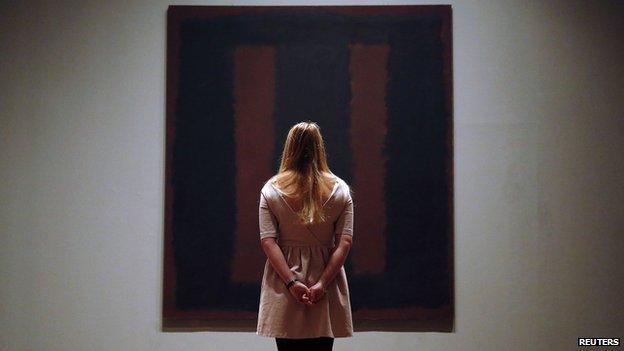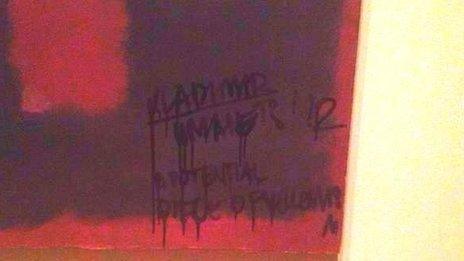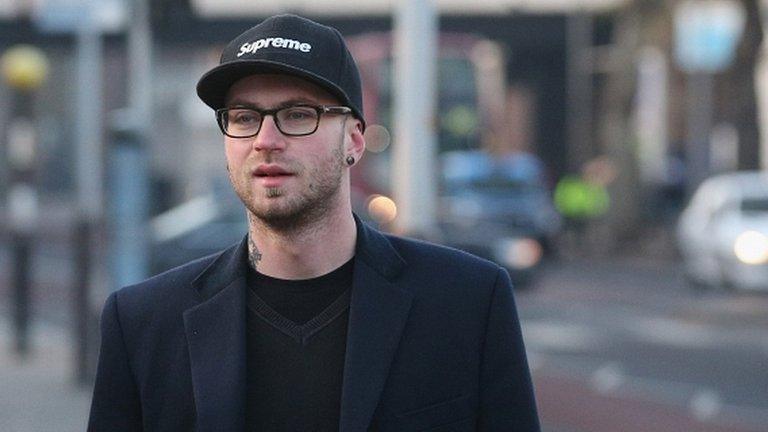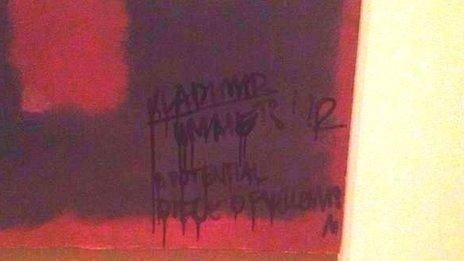Mark Rothko work goes back on display after vandalism
- Published

Two conservators spent 18 months restoring Mark Rothko's Black on Maroon
Mark Rothko's painting Black on Maroon has gone back on public display at London's Tate Modern gallery, 18 months after it was vandalised with graffiti.
The 1958 painting was defaced by Wlodzimierz Umaniec in October 2012. He was sent to prison as a result but has now apologised for his actions.
The Tate's conservators have spent 18 months repairing the painting.
Conservator Rachel Barker said: "It's definitely better than I could have hoped at the beginning of the project."
She added: "The nature of the damage was such that we did think the worst."
Ms Barker told BBC arts editor Will Gompertz the graffiti had covered "an area about the size of an LP" and some had seeped right to the back of the canvas. A vinyl record measures 12in (30cm) in diameter.
The conservators first created a replica of the painting and added graffiti before cutting it into strips and testing different types of solvent to see which was most effective at removing the graffiti.
They then retouched the damaged area.

Mr Umaniec added his signature and wrote "12 a potential piece of yellowism"
Mr Umaniec told the BBC before he was arrested that he was not a vandal, adding that "art allows us to take what someone's done and put a new message on it".
He said he was part of the "Yellowism" movement, whose manifesto describes itself as "not art or anti-art".
In a new statement, he said: "I apologise to [the] British people for what I did. I suppose I wanted to change the art world but of course I did it in a very, very wrong way.
"I spent almost a year and a half in prison and the British people have paid huge restoration costs, so it definitely wasn't worth dong it, and I'm sure the restoration team has done a wonderful job and I encourage everyone to see the restored picture."
Expensive operation
When the case went to court, Gregor McKinley, prosecuting, said the cost of repairing the work would be about £200,000.
Tate director Sir Nicholas Serota said: "Two people or more have been working on this for the last 18 months so you can imagine it was an expensive operation for us.
"The damage was very significant. It undoubtedly defaced the picture and really ruined it. The question was whether one could remove the damage without damaging the painting.
"Even the restorers and conservators were uncertain as to whether they could remove the ink and disguise the situation. They've done it brilliantly."
'Mad gesture'
Referring to the Umaniec, the man who vandalised the work, Sir Nicholas said: "I'm really sorry that he felt the necessity to do what he did and from time to time people make mad gestures of this kind. But art endures and these paintings will continue to be here for the next 50 or 100 years, I hope."
Black On Maroon had been given a pre-damage value of between £5m-£9m. Rothko paintings often sell for tens of millions of pounds.
Rothko originally created the work to hang in the Four Seasons restaurant in New York, but changed his mind and gave it to the Tate in 1969.
It will be hung in the Rothko room at the London gallery, a dimly-lit room hanging with other works from the same series.
- Published13 December 2012

- Published21 November 2012

- Published16 October 2012

- Published8 October 2012
